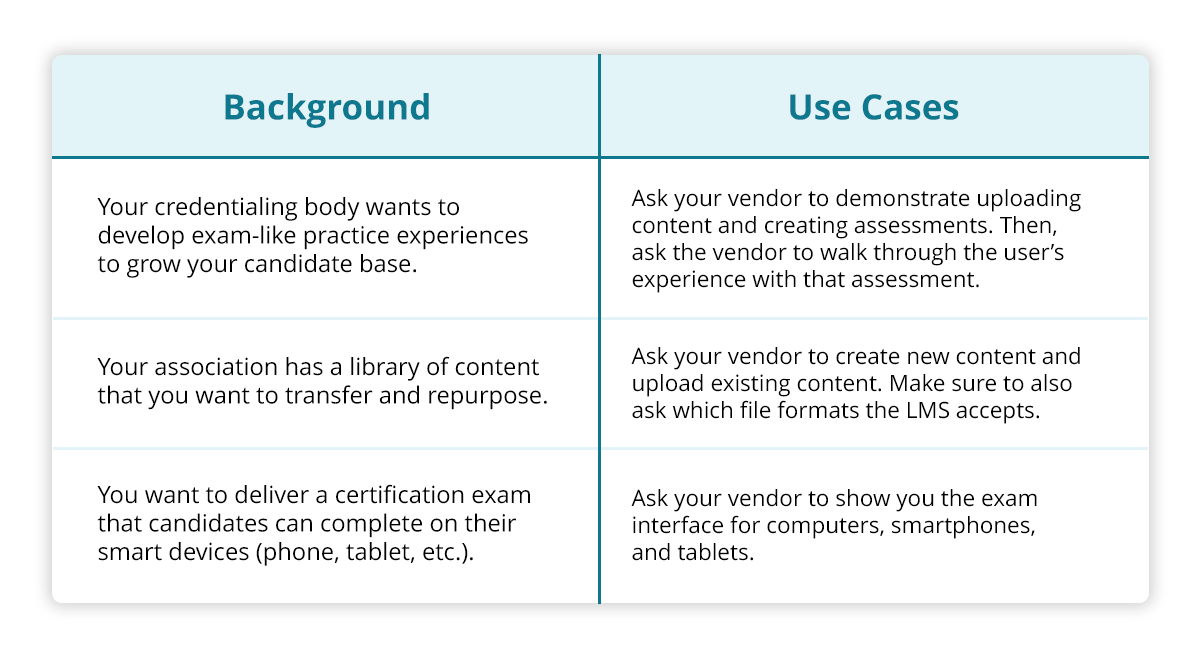Ready to Invest in a New LMS? Pump the Brakes.
It’s been in your viewfinder for a while now. Your certification training program needs a new learning management system (LMS).
Maybe you’re frustrated by an inadequate reporting hub or find yourself navigating a clunky user experience overall. Perhaps the LMS you chose doesn’t have the capabilities you need to boost your learners' confidence before their certification exam. Or maybe you haven't yet adopted an LMS in the first place, but know it’s time for one with a modern mobile experience and an easy-to-navigate user interface (UI). Whatever your situation may be, you're ready to take the next step and level up your certification program. First things first: it’s time to start researching vendors, right?
Wrong. Pump the brakes.
Before you invest in any new LMS, you’ll want to first complete some foundational groundwork. In this blog, we spell out four steps that can help associations and credentialing bodies confidently select their next LMS to ensure they see the best return on their investment.
Step #1: Determine Your Certification Program Objectives
Before selecting the bells and whistles that matter most for your next LMS (more on that later), it’s important that you first solidify your program objectives.
Not sure what those objectives might be? To identify them, consider the objectives of your certification training program as well as your overall business goals.
For example, let's say you administer your association’s certification training program. You have a business goal to improve member retention, with a corresponding program objective to continuously engage learners with your content.
Or maybe you support certification training at a credentialing body. And one of your business goals is to expand and diversify your candidate base. In this case, one of your program objectives might be to ensure candidates can reliably complete certification regardless of region, device, and level of internet access.

You’ll find that your program objectives also help clarify which LMS features are most beneficial to your certification program (e.g., if you want to promote equity and access, you may prioritize an LMS that offers omnichannel delivery).
But before you start identifying your LMS must-haves, you’ll want to complete step two.
Step #2: Detail Your Audience’s Needs and Expectations
Now that you’ve pinpointed your program objectives, it’s important to understand the needs and characteristics of your audience. Today’s certification program participants…
- Grow easily distracted. Today’s workers have longer attention spans than they’re often given credit for. Many, however, are burdened with frequent context-switching between different tasks or applications. That’s not great for productivity. It’s why the best certification training programs engage candidates without spreading their attention or energy levels thin.
- Want on-demand delivery. Time is precious. Many (if not most) people seeking credentials or certification are balancing a plethora of obligations at work and home as they constantly refine their work-life cycle. So make sure you can support the realities of candidates' dynamic calendars and ever-changing commitments.
- Frequently work remotely. Recent surveys show that as of 2023, more than a quarter of professionals enjoy hybrid work arrangements—and plenty more (98 percent) would take that opportunity to work a hybrid model if it were offered. Translation: your certification program should be easy to access from a variety of sources, including mobile, tablet, or desktop computer.
To be clear, these are overarching trends. Every organization is different. If your association, for example, serves younger professional learners, you may see a greater need to offer multimodal resources. (Case in point: the average member of Gen Z spends around 10 hours per week on TikTok alone.)
The larger takeaway is that digging deeper—taking the time to understand your audience—is critical to assessing your LMS needs.
Step #3: Collect LMS Must-Haves in One Document
Once you’ve outlined your program objectives and detailed your candidates’ needs, you can start jotting down must-have features for your next LMS. Think of this document as a checklist for when it comes time to research and narrow down LMS providers.
The point of this document is to help guide your buying process and ensure you don’t compromise on the capabilities you need. To help model such documentation, we’ve listed several popular features below as well as the reason(s) why they’re often integral to successful certification training.
Complex analytics and reporting hubs
Tracking candidate progress is key to successful certification training. Real-time insights help you make informed decisions on which topics to cover, how you cover them, and how your candidates feel about the experience overall.
Omnichannel delivery
We know that people spend more time on their mobile phones and tablets than they do on their computers. Your LMS should meet candidates where they’re at. Plus, optimizing your certification training program for mobile helps you reach candidates who may only have access to a phone or tablet. White-labeling capabilities
White-labeling capabilities
It’s not your vendor’s platform. It’s your platform. White-labeling helps you tie your LMS to the rest of your brand. It may seem small, but this consistency matters—especially when it comes to brand familiarity and growing your audience.
Gamification
Eighty-nine percent of people report being more productive when their work is gamified. But what does that gamification entail with your LMS? Often, it looks like completion badges, leaderboards, and activities like crosswords and flash cards. The impact for your candidates: higher levels of engagement and motivation.
Step #4: Document Use Cases in Anticipation of a Vendor Demo
The buying process for an LMS can take a bit of time. And that’s to be expected. You’re vetting technology that plays a crucial role in retaining and attracting your audience. But you can help move things along once you’re ready to buy. One way to do that: build use cases before meeting with vendors.
Organizations may hold off on this step until they’re done researching vendors and getting an abbreviated product demo. But documenting use cases before then can help keep your buying process:
- Efficient. You don’t need to wait until receiving a demo to internally draft use cases, get approval on those use cases, schedule a follow-up demo, and share those use cases with the vendor. That time between the initial demo and follow-up demo can take weeks—even months.
- Standardized. When you’re not building use cases in reaction to demos, you’re more likely to vet providers with the same criteria. This helps establish a more consistent, objective buying process.
To be clear, you can always iterate on your use cases as time goes by. But starting the buying process with several clearly identified use cases can help you maximize your efforts and save time. Curious what some of those might look like? We’ve listed examples below. You Don’t Need a Vendor—You Need a Partner
You Don’t Need a Vendor—You Need a Partner
Once you’ve identified the right LMS for your organization, it’s easy to look at that purchase as the final step. But finding an LMS isn’t just about choosing the right technology; it’s also about finding the right strategic partner.
Yes, you want an LMS that supports your organization’s and candidates’ needs. But that also includes finding an LMS provider that will continuously work alongside you—a partner that’s invested in your success.
Interested in learning how BenchPrep ticks the boxes we outlined here?






